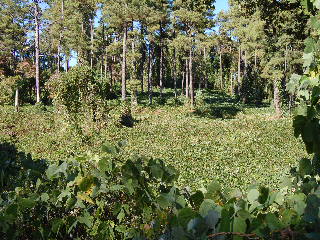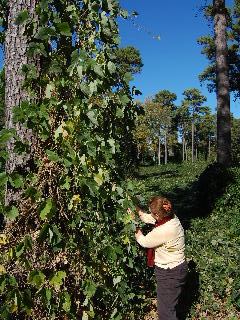
Kudzu is a funny little word that represents a funny little plant that is not always so funny.
Just the sound of the word conjures up visions of vegetation running rampant, like the theme of a bad horror movie where an invasive creeping vine covers and destroys the town—you know, like “The Kudzu That Consumed Kansas City!” or whatever. Maybe a bit overly dramatic, but not far from the truth.
But, let’s back up and start again so we can present an objective overview of kudzu. Surely there must be some good mixed in with all the bad we’ve heard about this plant.
First, the history. Kudzu is native to parts of Japan, China, and Southeast Asia where it has long been cooked and consumed as a food and utilized as a raw material in the weaving of baskets.
Kudzu was introduced into the United States in the 1800’s and was widely planted across areas of the southeastern U.S. during the 1930’s. The purpose in planting it was primarily for soil erosion control.
Because of its rapid rate of growth (up to 12 inches per day!) and because of the lack of significant natural or cultural means of controlling its growth, kudzu quickly spread and became an environmental menace, killing other vegetation by overgrowing it and choking out needed sunlight.
Kudzu is a legume that produces seeds in seedpods (much like soybeans). The seeds are one method of plant reproduction, as are reproduction and expansion by means of rhizomes and runners that quickly root and add to the difficulty of eradicating the plant.
Once kudzu has taken hold and begins to spread, it is very difficult to control or eradicate—being resistant to fire, herbicidal applications, and mowing and other mechanical treatments.
A combination of these controls is more effective than any one method used alone. Animal grazing (goats and cattle) is sometimes utilized in slowing the growth and spread of kudzu and the plant is in fact a suitable source of nutrition for livestock.

So, let’s use this information about kudzu being an acceptable animal food as the turning point in our overview of the plant and try to find something else good about it.
Being a legume, it does help add nitrogen to the soil and it does indeed help stabilize and prevent erosion in poor soils, so its original intention is being realized.
And its long and winding runners do have a great deal of fibrous strength, making it suitable for basket making and other fibrous art projects.
Kudzu has long been recognized as a food for human consumption and as an important plant in Chinese herbal medicine.
And medical research is being carried out in the U.S. and other countries testing the use of kudzu as a treatment for alcoholism and other diseases.
In the meantime, hopefully we will learn to not so easily and quickly introduce non-native species into our environment—they may be easier to get started than to get rid of.
The photographs in this article were taken at Natchez Trace State Park in western Tennessee.
 Kudzu is a funny little word that represents a funny little plant that is not always so funny.
Kudzu is a funny little word that represents a funny little plant that is not always so funny.
 So, let’s use this information about kudzu being an acceptable animal food as the turning point in our overview of the plant and try to find something else good about it.
So, let’s use this information about kudzu being an acceptable animal food as the turning point in our overview of the plant and try to find something else good about it.